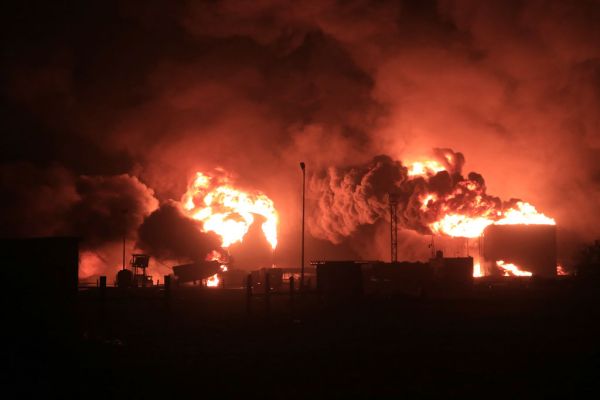Hamas’ horrific October 7 attack on Israel has ignited a war that risks plunging the Middle East into broader conflict that could draw in the United States. The war has already expanded beyond Israel, as Iranian-backed militias in Lebanon, Syria, Iraq, and even Yemen have mobilized in support of Hamas and have begun attacking Israeli and U.S. targets throughout the region. These militias are part of a transnational coalition called the “Axis of Resistance,” built up over decades by Iran for the explicit purpose of attacking the United States and Israel on multiple fronts at the same time.
The Axis of Resistance consists of state, semi-state, and non-state actors, including the Iranian regime, the Bashar al-Assad regime in Syria, Hamas, Hezbollah in Lebanon, the Houthi movement in Yemen, and myriad other militias made up of Afghan, Bahraini, Iraqi, Palestinian, Pakistani, and Syrian fighters deployed throughout the region. Iran directly founded some of the groups in the alliance after its revolution in 1979, while others emerged independently and later forged ties with Tehran. Iran furnishes these groups with varying levels of financial, military, and political support in exchange for some degree of influence or control over their actions. Some are traditional proxies that are highly responsive to Iranian direction while others are partner militias over which Iran exerts more limited influence.
Members of Axis of Resistance are united by their commitment to eroding and eventually expelling American influence from the Middle East, destroying the Israeli state, or both. Pursuing these objectives and supporting the Axis of Resistance to those ends have become cornerstones of Iranian regional strategy.
Iranian leaders have invested immense energy, resources, and time over the past few decades into turning the Axis of Resistance into a formidable military power, one that allows it to apply and project force, deter and coerce foreign actors, and shape the regional environment. This military alliance helps Iran advance its campaigns against the United States and Israel, while also supporting its bid for regional hegemony.
The Islamic Revolutionary Guard Corps (IRGC) is the primary organization for managing support to the network of militias. The IRGC reports directly to the Iranian supreme leader and operates with significant independence and minimal accountability and oversight. Iran—through the IRGC—provides direction, intelligence, logistical support, weapons, and other kinds of military hardware to the other members of the Axis of Resistance. The IRGC in more recent years has focused on outfitting the militias with advanced military capabilities, such as long-range drones and missiles, as well as promoting greater cohesion across its members, driving them to work alongside one another more closely.
The best example of the axis functioning as a military coalition is the Syrian civil war, in which Iran brought its proxies together to preserve the Assad regime. The IRGC organized the deployment of thousands of fighters and put them under Iranian command to battle the Islamic State and Syrian opposition. It was the first time the IRGC rallied the parties of the Axis of Resistance to undertake protracted military campaigns at such a scale and even deployed its own combat units to fight abroad. This intervention to save a critical node in the alliance exemplified how the Axis of Resistance has prepared to fight high-intensity wars to secure its collective interests.
Another example is how Iran has armed the Houthis in Yemen with drones and missiles that can reach most of the Middle East. The Houthis are a Zaydi Shiite movement that launched a coup in Yemen in 2014 and kicked off the civil war that has devastated the country since then. The Gulf states intervened in the war in 2015 to contain the Houthis, as they moved closer to and began receiving military support from Iran. The Houthis have enabled the axis to open another front—this time from the south—against U.S. and its partners, such as Saudi Arabia, the United Arab Emirates and even Israel. The Axis of Resistance now threatens the U.S. and its partners from most cardinal directions in the region.
The Axis of Resistance is now working to preserve Hamas as Israel launches a ground operation into the Gaza Strip. Iran and its alliance are pursuing three strategic objectives: 1) deter Israel from trying to destroy Hamas in the Gaza Strip, 2) prevent Israel from destroying Hamas if deterrence fails, and 3) deter the United States from providing meaningful military support to Israel. To that end, Hezbollah and the Houthis have begun attacking Israel from the north and south, respectively, to draw Israeli attention and resources away from the Gaza Strip and threaten further escalation. Iranian-backed Iraqi militants have meanwhile conducted dozens of attacks on U.S. military positions in Iraq and Syria in recent weeks, demonstrating the capability and willingness to turn the war into a larger regional conflict. The potential for the war to escalate is high, as Iran could perceive opportunities and/or threats in the coming weeks that motivate it to turn up the pressure against both the United States and Israel.
The challenge that Iran and its proxies now pose to Washington underscores a broader lesson about U.S. policy in the Middle East: The past three administrations have sought to disentangle the United States from the region, only to discover it’s not really an option. Neglecting the imperative to promote stability and secure U.S. interests has led to an eruption of crises—not just in Syria, but civil war in Yemen, gradually expanding Iranian control in Iraq, and an enduring ISIS challenge that is not defeated. Deprioritizing the region has proved to be counterproductive, as the U.S. is inevitably dragged back in. Nothing illustrates that more than the current crisis, which demands attention and resources from U.S. policymakers at a time they are also contending with the war in Ukraine and threats from China. The threat from the Axis of Resistance demonstrates why it’s imperative for the United States to remain engaged in the Middle East in a proactive and sustained fashion.








Please note that we at The Dispatch hold ourselves, our work, and our commenters to a higher standard than other places on the internet. We welcome comments that foster genuine debate or discussion—including comments critical of us or our work—but responses that include ad hominem attacks on fellow Dispatch members or are intended to stoke fear and anger may be moderated.